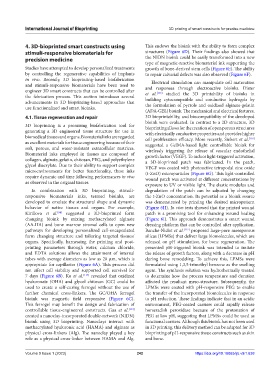Page 250 - IJB-9-1
P. 250
International Journal of Bioprinting 3D printing of smart constructs for precise medicine
4. 3D-bioprinted smart constructs using This endows the bioink with the ability to form complex
stimuli-responsive biomaterials for structures (Figure 6D). Their findings also showed that
precision medicine the NIDN bioink could be easily transformed into a new
type of magnetic-reactive biomaterial ink supporting the
Studies have attempted to develop personalized treatments growth of bone-derived stem cells (Figure 6E). The ability
by controlling the regenerative capabilities of implants to repair calvarial defects was also observed (Figure 6F).
in vivo. Recently, 3D bioprinting-based biofabrication Electrical stimulation can manipulate cell maturation
and stimuli-responsive biomaterials have been used to and responses through electroactive bioinks. Dister
engineer 3D smart constructs that can be controlled after [115]
the fabrication process. This section introduces several et al. studied the 3D printability of bioinks in
advancements in 3D bioprinting-based approaches that building cytocompatible and conductive hydrogels by
the formulation of pyrrole and oxidized alginate-gelatin
use functionalized and smart bioinks.
(ADA-GEL) bioink. The mechanical and electrical features,
4.1. Tissue regeneration and repair 3D bioprintability, and biocompatibility of the developed
bioink were evaluated. In contrast to a 2D structure, 3D
3D bioprinting is a promising biofabrication tool for bioprinting allows for the creation of open porous structures
generating a 3D engineered tissue structure for use in with electrically conductive properties and provides higher
biomedical tissues and organs. Biomaterial inks are regarded cell proliferation efficacy. More recently, Siebert et al. [116]
as excellent materials for tissue engineering because of their suggested a GelMA-based light controllable bioink for
soft, porous, and water-resistant extracellular matrices. wirelessly triggering the release of vascular endothelial
Biomaterial inks employed in tissues are composed of growth factor (VEGF). To induce light-triggered activation,
collagen, alginate, gelatin, chitosan, PEG, and polyethylene a 3D-bioprinted patch was fabricated. In the patch,
glycol diacrylate. Due to their ability to support complex VEGF was coated with photoactive tetrapodal zinc oxide
microenvironments for better functionality, these inks (t-ZnO) microparticles (Figure 6G). This light-controlled
require dynamic and time following performances in vivo wound patch was activated at different concentrations by
as observed in the original tissues. exposure to UV or visible light. The elastic modulus and
In combination with 3D bioprinting, stimuli- degradation of the patch can be adjusted by changing
responsive biomaterials inks, termed bioinks, are the t-ZnO concentration. Its potential as a bioink source
developed to emulate the structural shape and dynamic was demonstrated by printing the desired micropattern
behavior of native tissues and organs. For example, (Figure 6H). In vivo tests showed that the printed wound
[94]
Kirillova et al. suggested a 3D-bioprinted form patch is a promising tool for enhancing wound healing
changing bioink by mixing methacrylated alginate (Figure 6I). This approach demonstrates a smart wound
(AA-HA) and bone marrow stromal cells to open new dressing platform that can be controlled after application.
pathways for developing personalized cell-encapsulated Banche-Niclot et al. [117] proposed large-pore mesoporous
form changing structure and tailoring targeted tissues/ silicas (LPMSs) that deliver large biomolecules, which are
organs. Specifically, harnessing the printing and post- released on pH stimulation, for bone regeneration. The
printing parameters through water, calcium chloride, presented pH-triggered bioink was intended to imitate
and EDTA solutions allows the attainment of internal the release of growth factors, along with a decrease in pH
tubes with average diameters as low as 20 μm, which is during bone remodeling. To achieve this, LPMSs were
appropriate for capillaries (Figure 6A). This process did formulated using 1,3,5-trimethyl benzene as the swelling
not affect cell viability and supported cell survival for agent. The synthesis solution was hydrothermally treated
7 days (Figure 6B). Ko et al. [113] revealed that oxidized to determine how the process temperature and duration
hyaluronate (OHA) and glycol chitosan (GC) could be affected the resultant meso-structure. Subsequently, the
used to create a self-curing ferrogel without the use of LPMSs were coated with pH-responsive PEG to enable
further chemical cross-linkers. The GC/OHA ferrogel the transfer of the incorporated biomolecules in response
bioink was magnetic field responsive (Figure 6C). to pH reduction. These findings indicate that in an acidic
This ferrogel may benefit the design and fabrication of environment, PEG-coated carriers could rapidly release
controllable tissue-engineered constructs. Gua et al. [114] horseradish peroxidase because of the protonation of
created a nanoclay-incorporated double-network (NIDN) PEG at low pH, suggesting that LPMSs could be used as
bioink using 3D bioprinting. Nanoclays interact with functional carriers. Although this bioink has not been used
methacrylated hyaluronic acid (HAMA) and alginate as in 3D printing, this delivery method can be adapted for 3D
physical cross-linkers (Alg). The nanoclay played a key bioprinting of pH-responsive tissue constructs such as skin
role as a physical cross-linker between HAMA and Alg. and bone.
Volume 9 Issue 1 (2023) 242 https://doi.org/10.18063/ijb.v9i1.638

